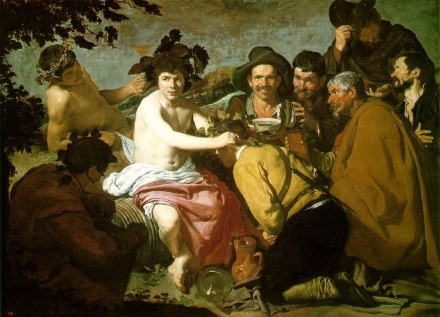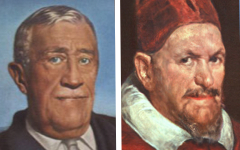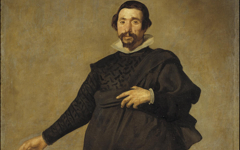Velazquez’s Bacchus (c.1628-9)
Velazquez painted this picture for the king of Spain who must have received some explanation from the artist. The rest of us have been left to guess what it means, mostly without success. The more one looks, the more questions it raises. Let's study it a bit.
Why is a classical god, Bacchus, partying with a group of contemporary Spanish peasants? Why is he crowning the kneeling soldier while glancing out the picture to the left? What has he seen? Why do the two men next to him smile as though mugging for a camera? How can Bacchus hold the wine so still that there is no ripple on its surface? Scholars have argued these points for more than a century but without the crucial fact Steven Orso revealed in 1993 they could make no headway.1
Click next thumbnail to continue
Orso's discovery that seventeenth-century Spaniards believed that Bacchus had visited Spain and had become its first ruler explains why Philip IV was so interested in the subject. It also explains, even more significantly, how Velazquez would have identified with the central figure both as god of wine (alcohol stimulates the imagination) and Spain's first monarch who was both royal and divine. The divine Spanish king, the original king, however simple he may appear in the image, was the perfect symbol for Velazquez's own purified soul as Spain's greatest master, the rank the still-young artist clearly aspired to.
Click next thumbnail to continue

Left: Copy after Rubens, Equestrian Portrait of Philip IV Oil on canvas. Uffizi, Florence
Click image to enlarge.
The older Rubens was in Madrid for eight months while Velazquez was painting this picture and the two artists spent a lot of time together. The Spaniard must have noticed, if he had not already, that Rubens like Titian and other masters fused his own face with those of his sitters'. Rubens' portrait of Velazquez's own king, Philip IV, was remarkably similar to several of Rubens' self-portraits, not only in facial features like the large eyelid and moustache but in the pose and headwear too.
Click next thumbnail to continue

Goya, After Velazquez, A False Bacchus Crowning Some Drunkards Engraving on paper
Click image to enlarge.
Goya in the next century engraved the composition his own way, revealing similar ambition. He must have understood its meaning. In brief, Bacchus crowns a young soldier kneeling and facing the picture as the artist would have when painting it. The only other figure facing inwards, shaded in the foreground, crouches somewhat like an artist in his studio and is already crowned. He is "outside" the painting imagining his döppelganger, the soldier, being honored by Bacchus.
Click next thumbnail to continue
Now note how the soldier's head, the artist's "mind", is dead center with his dagger behind him representing a "paintbrush". He and Bacchus are surrounded by what Velazquez may have imagined were his own realistic "paintings" of poor people. The wine's surface near the center too is magically still like a mirror, suggesting a transition point between one reality and another. This new interpretation is only a start. Without it, however, no interpretation will get far. Yet it all hangs on a single fact that Orso devoted a whole book to revealing. He deserves the credit.
More Works by Velazquez
Notes:
1. Steven N. Orso, "Los Borrachos" and Painting at the Court of King Philip IV (Cambridge University Press) 1993, pp. 97-108
Original Publication Date on EPPH: 25 Apr 2012. | Updated: 0. © Simon Abrahams. Articles on this site are the copyright of Simon Abrahams. To use copyrighted material in print or other media for purposes beyond 'fair use', you must obtain permission from the copyright owner. Websites may link to this page without permission (please do) but may not reproduce the material on their own site without crediting Simon Abrahams and EPPH.






